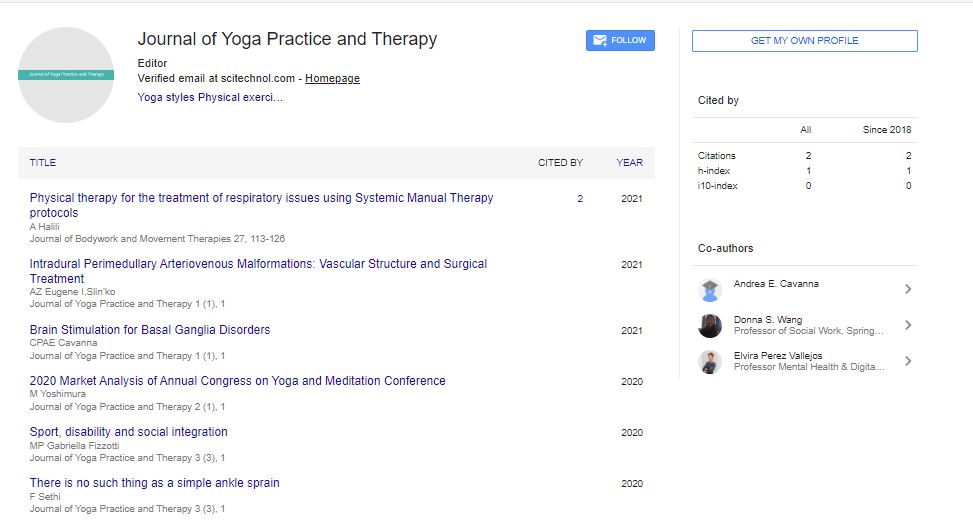Commentary, J Yoga Pract Ther Vol: 4 Issue: 1
A Short Note On Spiritual Traditions And Mental Well-Being
Nibedita Dalpati*
Department of Biosciences and Bioengineering, Indian Institute of Technology Roorkee, Uttarakhand, India
*Corresponding Author: Nibedita Dalpati Department of Biosciences and Bioengineering, Indian Institute of Technology Roorkee, Uttarakhand, India, E-Mail: dalpatinibedita1@ gmail.com
Received: 03 November, 2021; Accepted: 10 November, 2021; Published: 24 November, 2021
Keywords: Yoga Practice,Therapy, therapeutic practice of yoga,n Spiritual Traditions ,Mental Well-Being
Introduction
Contemplation is a technique in which a person utilises a method - such as care or focusing one's thoughts on a certain article, thought, or action - to prepare for consideration and mindfulness, and to achieve an intellectually clear, genuinely quiet, and stable state. Contemplation is pounded into people through a variety of severe procedures. The Upanishads include the earliest records of reflection (dhyana), and reflection plays an important role in Buddhism and Hinduism's profound collections. Asian mindful tactics have expanded to other nations throughout the eighteenth century, where they have also found use in non-otherworldly circumstances. Such as business and health. Reflection can help to reduce stress, tension, melancholy, and misery while also improving harmony, insight, self-idea, and wealth. Research is evolving to better understand the effects of reflection on mental, neurological, and cardiovascular health, as well as other areas.
The framework of Jain pondering and otherworldly activities was referred to as a salvation-way. The Ratnatraya refers to it as having three sections: right insight and confidence, proper information, and right lead. In Jainism, contemplation focuses on comprehending oneself, achieving salvation, and leading the soul to complete liberation. It aspires to arrive at and remain in the pure state of spirit, which is understood to be unadulterated awareness, free of any attachment or aversion. Only a knower-soothsayer is the professional's goal (Gyata- Drashta). Dharmya Dhyana and Shukla Dhyana are the two broad categories of Jain contemplation.
Thought is an extremely old and important method of reflection. The expert ponders deeply on unpretentious reality. In agnya vichya, one considers seven realities: life and non-life, karmas influx, subjugation, stopping, and evacuation, and the final attainment of liberation. In apaya vichya, one reflects on one's erroneous experiences, which leads to the development of correct knowledge. The eight causes or primary types of karma are contemplated in vipaka vichya. One contemplates the limitlessness of the universe and the forlornness of the spirit in sansathan vichya.
Hinduism
Within Hinduism, there are numerous schools and ways of thinking. Yoga and Dhyana are practised in pre-modern and traditional Hinduism to see 'unadulterated mindfulness', or 'unadulterated awareness,' unaffected by brain operations, as one's everlasting self. Individual self is regarded as frivolous in Advaita Vedanta, and is in reality indistinguishable from the universal and non-dual tman-Brahman. Purusha, an unadulterated consciousness untouched by Prakriti, 'nature,' is the name given to the Self in the dualistic Yoga school and Samkhya. Depending on the tradition, the liberating event is referred to as moksha, vimukti, or kaivalya. The Upanishads of India contain some of the oldest references to contemplation as well as proto-Samkhya. The Upanishads and the Mahabharata contain the earliest unequivocal allusions to introspection (counting the Bhagavad Gita). According to Gavin Flood, the previous Brihadaranyaka Upanishad depicts contemplation when it says, "having gotten calm and thought, one sees oneself inside oneself."
Sikhism
The Upanishads of India contain some of the oldest references to contemplation as well as proto-Samkhya. The Upanishads and the Mahabharata contain the earliest unequivocal allusions to introspection (counting the Bhagavad Gita). According to Gavin Flood, the previous Brihadaranyaka Upanishad depicts contemplation when it says, "having gotten calm and thought, one sees oneself inside oneself."
 Spanish
Spanish  Chinese
Chinese  Russian
Russian  German
German  French
French  Japanese
Japanese  Portuguese
Portuguese  Hindi
Hindi 